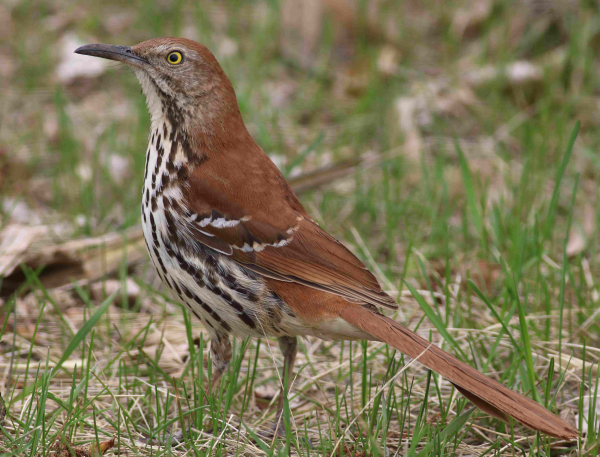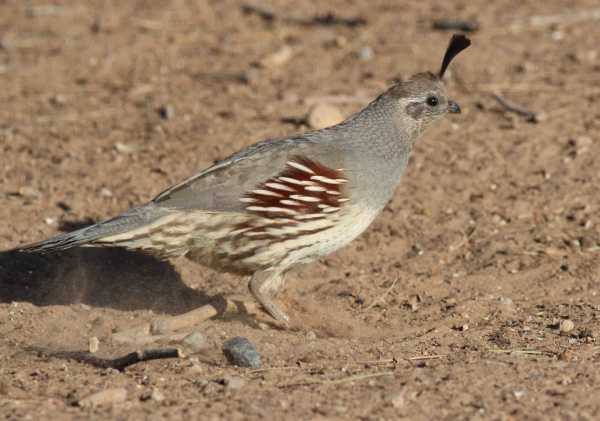
Brown Thrashers are among a long list of birds that are known to dust bathe.

How interesting to witness a Brown Thrasher dust bathing.

A female Gambel’s Quail prepares a shallow basin for dust bathing.
|
Feathers are marvelous and intricate creations, but keeping feathers functional requires constant care. The amount of time and effort birds put into preening, bathing, and dusting indicates how critical feather maintenance is for each individual. Dust bathing may be one of the least understood maintenance behaviors, and we usually don’t get to observe this activity. But by creating a small dust bath in your yard, perhaps near your feeding station or another preferred site, you can attract birds to dust bathe in a location where you have a full view.
For some birds that live in areas where standing water is not readily available, dust bathes become substitute for water bathing. However, there are some birds that just seem to prefer a dust bath, perhaps as an alternative, or a second bathing option. Birds create their own shallow basins in fine dry soil by scraping an area in the ground, then lying down in the dirt and throwing dust over their bodies using their wings, spreading their tail and rubbing their breast and head in the dry wallow. The dust is first sifted through the feathers, then shaken out in a series of maintenance ruffles. Preening usually follows a dust bath, and it’s all part of caring for their plumage and skin.
Actually, more than 200 species worldwide are known take dust baths. Ground-oriented birds are most likely to be seen dust bathing in this corner of the world, including native sparrows, House Sparrows, thrashers, wrens, larks, quail, grouse, pheasants, and turkeys commonly take dust baths and it will be interesting to see which birds that frequent your yard will utilize a dust bath that you provide. Unlike providing fresh water for bathing and drinking, it’s not necessary to have a dust bath available all the time, but you can use it as something of a treat for area birds that like the option.
Position your dust bath in a sunny location, in an open area where birds will feel safe and can see their surroundings at all times. An appropriate size for a dust bath might be a minimum of 5 inches by 3 inches for a songbird, and 8 inches by 4 inches for larger birds such as quail. It might be a good idea to provide 2 or 3 baths in fairly close proximity – say a foot apart. But try making a larger area of exposed dry dirt and give birds a hint by scratching a shallow basin to give birds the idea so they will fashion their own dirt basins for dust bathing.
You can also try making mobile dust baths that you can provide when conditions are dry, and remove them during rainy periods or when impending rain is forecast. Rather than leaving a dust bath in the elements, it’s best to be able to remove it before rain falls, or you can cover a more permanent dust bath.
Mobile dust baths can be made of a wood frame and tray-like bottom with drainage holes. Then position it in an open sunny location, and add a few inches of fine dry soil. You could also use a shallow ceramic or clay pottery basin to hold the “dust,” but without drainage holes, it may require a bit more maintenance. Even so, a mobile dust bath is a bit easier to maintain, and clean, if necessary.
The reaction of birds to a new dust bath may be immediate, or it may be delayed, but as with any new birding equipment, give it a try, and have some patience. It may prove a big hit, and if so, it will be a benefit to the birds that use it. August is prime time to try adding a dust bath to your backyard birding mix, and if you get a good response, dust baths will undoubtedly become an annual addition to your yard.
Share your birding experiences and photos at editorstbw2@gmail.com